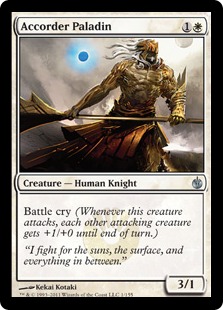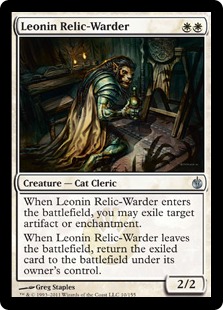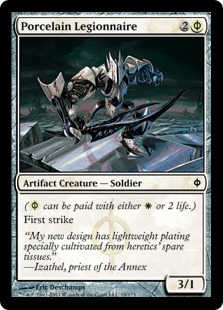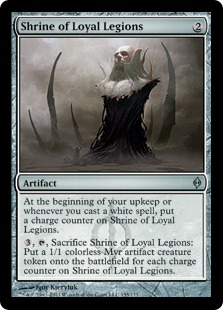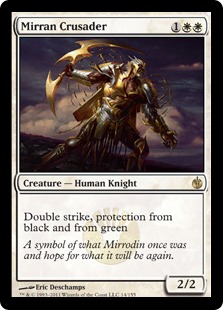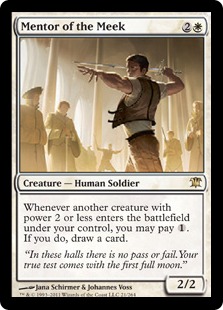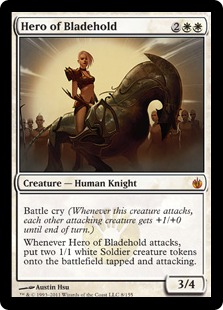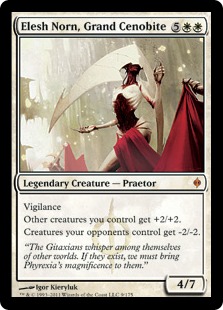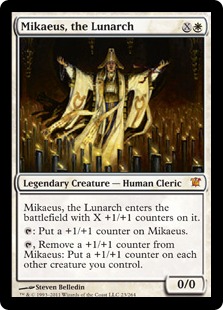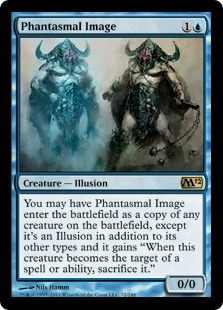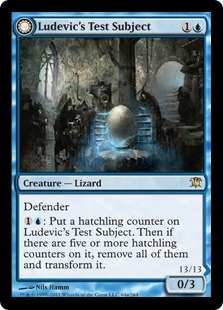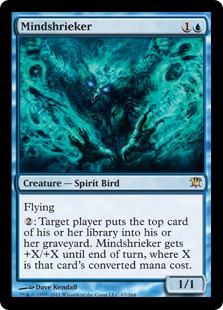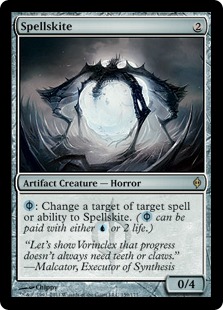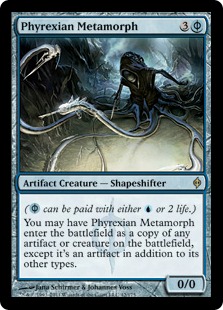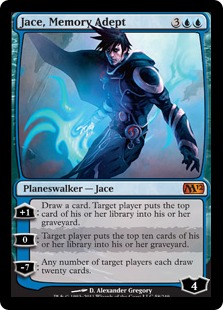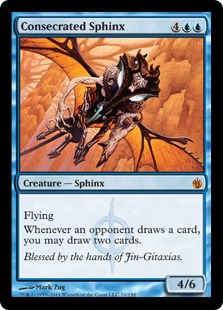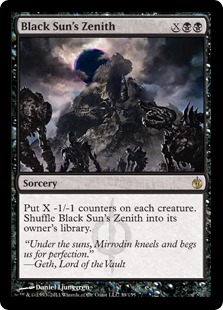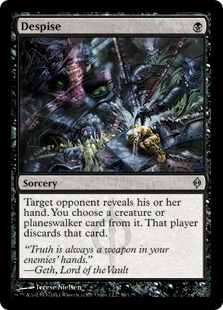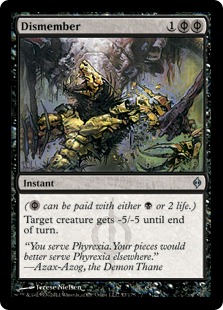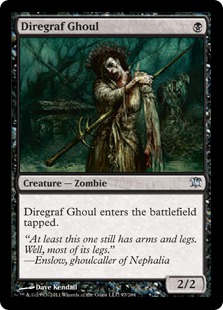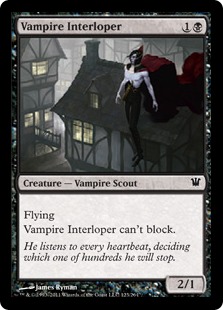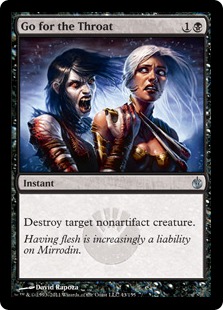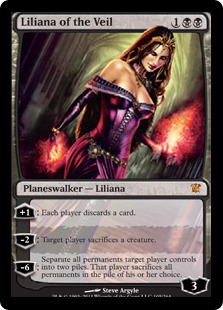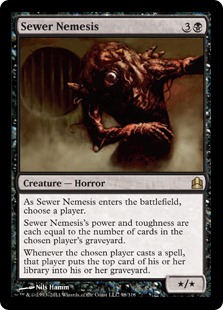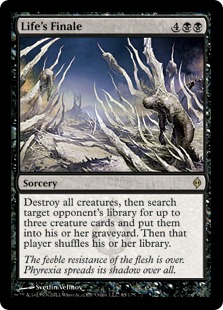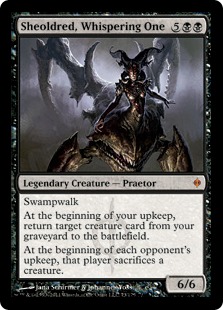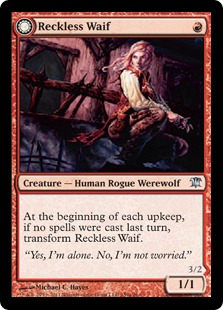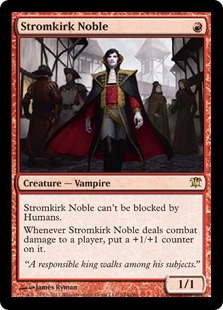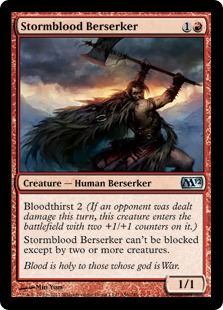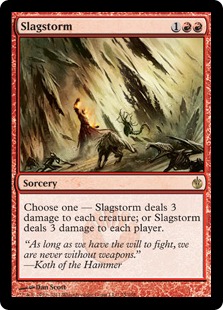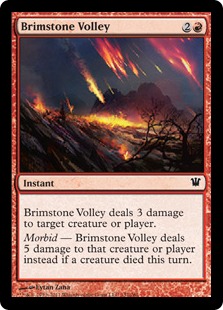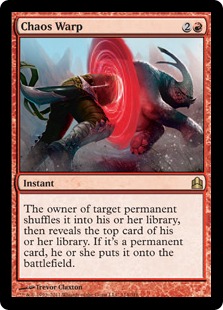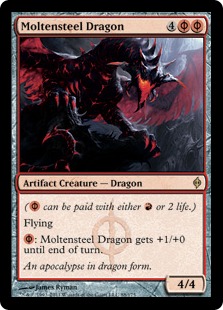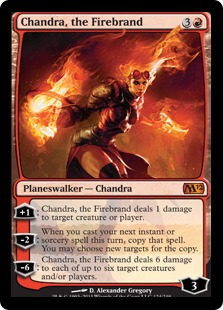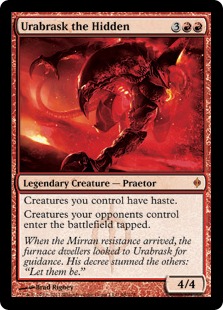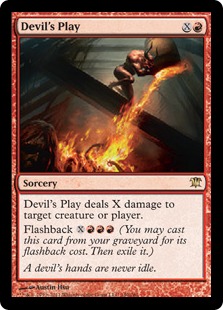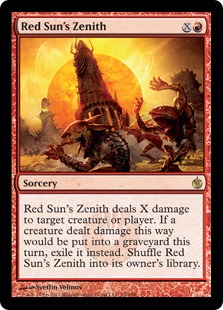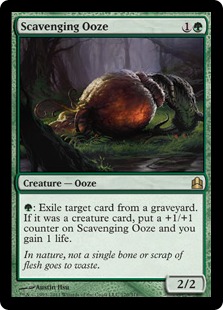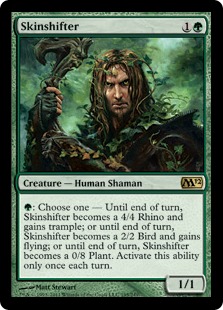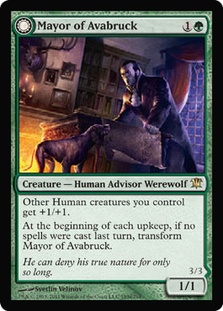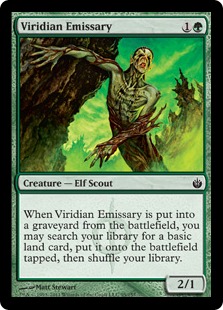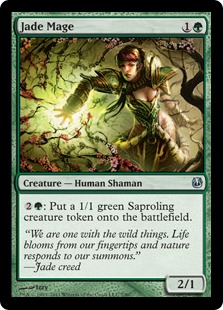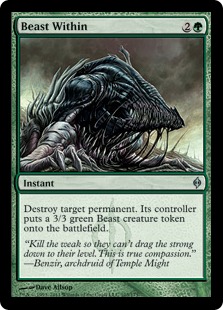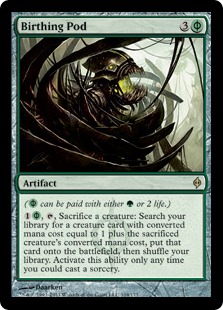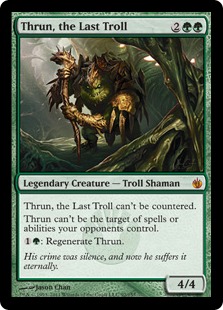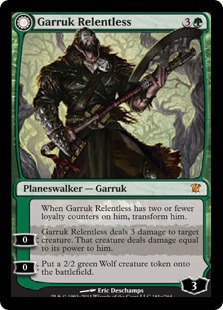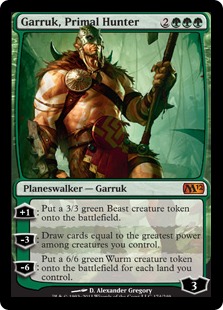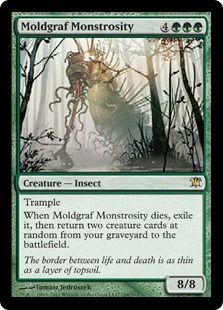With 2011 coming to a close and with the year bringing five sets—Mirrodin Besieged, New Phyrexia, Commander, Magic 2012 and Innistrad—there’s no better time than now to do a year-end retrospective of cube with this year’s set. In this article, I’ll be covering the top 5 cube cards in each color and do a basic rundown for what each color got in terms of cubeworthy cards.
White:
#5/#4/#3 – Cloistered Youth, Accorder Paladin, and Porcelain Legionnaire
People like Tom LaPille stressed that a white section in cube shouldn’t become overburdened with white creatures that have WW as the mana costs, as this tends to make white decks either have really bad mana or require the decks to be nearly mono-white with a splash of another color to work properly. All three of these creatures help bolster aggressive white cube decks and serve a similar purpose of representing three power for two mana. They are both at pretty similar power levels, but Cloistered Youth ends up at the back of the pack for its inability to deal with 2+ toughness creatures pre-flip (not even counting its drawback, which tends to be irrelevant, as aggro decks don’t usually care about the life loss). The usefulness of Accorder Paladin’s battle cry ability can be mitigated without friends to back it up, but its overall power level is very solid. However, Porcelain Legionnaire ends up at the top of the pack because of its extreme ease in casting as well as first strike, which cuts through anything short of a Baloth.
#2 – Hero of Bladehold. When Jace got the Standard ban hammer, people started to realize the power of Hero of Bladehold, as it no longer needed to fear the huge tempo loss from bouncing; in cube, despite Hero “failing the Terminate test,” she is one of the creatures that shows that the Terminate test isn’t a surefire way of showing a card’s strength. Much like in Constructed, her attacking twice (or arguably once) typically ends games, strengthening the aggro clock.
#1 – Mirran Crusader. An unsurprising #1, Mirran Crusader has been excellent in aggressive, midrange, and control decks, offering a lot of power alongside dual protection. White three-drops tend to be on the weaker side, paling in comparison to white’s insane four-mana cards, but Mirran Crusader holds up very well.
Honorable mentions: Elesh Norn, Grand Cenobite
Elesh Norn was a card that many people, myself included, dismissed, as I figured that its inability to kill X/2s would be nearly useless on turn 7—or that it’d just die to a Terminate / Path to Exile. Much like with Hero of Bladehold, I found that the “Terminate test” didn’t invalidate Elesh Norn, as even on turns 7+, there is almost always a 2/2 or two (usually a utility creature like Viridian Shaman or Nekrataal) that dies to Elesh Norn, and opposing creatures can’t kill her aside from ones with deathtouch. At first, I thought that her good performance was a fluke and that she’d die after eating a removal spell, but that didn’t end up happening for me or others who have used her in cube.
Overall:
White’s two-drops have always been strong, the bread and butter of strong white-based aggressive decks. 2011 brought a lot of ones with three power that we discussed earlier, but white also got a few other strong ones like Leonin Relic-Warder and Shrine of Loyal Legions. With the exception of Elesh Norn, white didn’t get that much in terms of control finishers, as well.
Blue:
#5 – Phantasmal Image
Clone effects for cube prior to 2011 have unfortunately been on the loose side for cube, as cards like Clone, Rite of Replication, and Vesuvan Shapeshifter just aren’t used in cube lists nowadays, and the first two hadn’t been used in many cubes for a while. Jamie Wakefield once said that the worst thing about playing green fatties is that blue can just steal the creatures—and while Phantasmal Image doesn’t outright steal the creature, its copying an “enter the battlefield” trigger can retain a lot of the original creature’s value. While the drawback can matter in cube, especially since cards like Ring of Gix and Staggershock that can target it without using a card are used more often, the fear of the drawback mattering is more than the actual drawback.
#4 – Phyrexian Metamorph
While Phantasmal Image is guaranteed to copy an enter-the-battlefield trigger and then have value after, Phyrexian Metamorph has been the better of the two clone effects for cube because of its ability to copy a creature for three mana without the creature being able to die. I figured that the ability to copy artifacts would happen about 10% of the time when it is cast, and I have found that percentage to be pretty accurate.
#3 – Spellskite
Sometimes, all you really need is an 0/4 creature to give you some breathing room. Cube designers initially dismissed Spellskite as a mediocre aggro-hoser, but it instead ended up being a solid way to defend creatures (a la Mother of Runes), planeswalkers, or players easily. Many people considered Spellskite to be on the lower tier of blue cards (because let’s face it, Spellskite is best used in U/X decks, as I’d have to be in pretty bad shape to be forced to use its redirection ability), but it’s arguably a modern-day staple for cube.
#2 – Jace, Memory Adept
The best Nemesis of Reason ever. Many cubes took out either an expensive draw engine or a weak finisher for “new Jace,” as it is an easy upgrade. In a color that isn’t struggling for quality finishers (generally better ones than green, the “creature color!”), Jace, Memory Adept has since risen to one of the best finishers in cube. I remembered seeing some dismiss Jace, Memory Adept because it could not defend itself, but playing it into a board that can kill him without protection is more the error of the user, not the card itself.
#1 – Snapcaster Mage
There isn’t too much to say that wasn’t already said in my Innistrad cube review, aside from stating that while he does lose value in unpowered lists, he is still the best blue card in cube.
Honorable mention: Consecrated Sphinx
Much like with Elesh Norn, many people dismissed Consecrated Sphinx because it failed the Terminate test (if he died to an instant-speed removal spell at end of turn, you wasted a ton of tempo, as he died with no effect other than drawing out a removal spell). Once people started to give him a shot in cube, people found out that he was much better than expected; the fear of him dying without doing anything was mostly unfounded, as he typically drew cards and was a big step towards ending the game. When thinking of him as a bigger Graveborn Muse, Thieving Magpie, or Bloodgift Demon, his value went up. The jury is still out on whether he’s better than existing blue finishers like Keiga, the Tide Star, Sphinx of Jwar Isle, Palinchron, and Frost Titan, but he’s definitely up there and only got edged out of the top 5 blue cards in 2011 because of insane competition.
Overall:
Surprisingly, blue ended 2011 with a high amount of cubeworthy two-drops, encouraging archetypes like the aggressive/tempo decks. If we have another year like 2011 with some more solid two-mana and three-mana creatures for cube, expect cards like Standstill, Opposition, and Wake Thrasher to become more highly adopted in cube, as those cards are much better in blue decks with 10+ creatures than ones with fewer than 5.
Black:
#5 – Bloodgift Demon
As mentioned before, Bloodgift Demon wasn’t too far from what was expected of him as a solid flier with Phyrexian Arena attached onto it, but what may have been more surprising was not only how good the five power was but that he was also really good in control decks. He’s a natural curve-topper for aggressive decks that don’t care about the life loss, as it helps fuel their hands with cards; aggressive decks are better able to use the ability to target an opponent, which is nice since Innistrad gives some nice tools for black aggressive decks like…
#4 – Diregraf Ghoul
Diregraf Ghoul didn’t really surprise anyone who used it, the best black one-drop in cube and an upgrade to cards like Vampire Lacerator, Carnophage, and Sarcomancy (albeit, an upgrade that shouldn’t result in taking one of those cards out). Diregraf Ghoul represents an increase in black aggro support, which will hopefully be seen more in 2012.
#3 – Go for the Throat
Easy upgrades are easy, and many cubes ended up switching Terror out for Go for the Throat, as the ability to hit black creatures was much better than regeneration hosing. When Go for the Throat was first printed, people assumed that they would be able to keep Doom Blade, Go for the Throat, and Terror in their cubes, but eventually cube designers found that standalone creature kill spell slots are limited, especially with black having a lot of “187” creatures (Nekrataal, Shriekmaw) and other amazing creature kill spells, such as…
#2 – Dismember
Dismember may be black’s best creature removal spell; it has some hard competition with cards like Snuff Out and Go for the Throat, but Dismember’s versatility has been enough to push it into the upper echelon of cube removal spells, especially for colors like blue and green that don’t get many creature removal options.
#1 – Liliana of the Veil
Black planeswalkers have been on the loose side with Vess having little board impact for five mana (in a color of strong finishers at five mana like Bloodgift Demon) and being best against slow decks. Sorin Markov, while it had a very good +2 ability, also paled in comparison to other cards at the same mana cost, especially since it couldn’t protect itself against bigger creatures like the Baloths found in midrange decks. (Granted, many cubes, mine included, use Sorin Markov to success, but he’s on the lower end of planeswalkers that are in my cube.) While Liliana of the Veil is weaker than Jace, Memory Adept and arguably one or both of the new Garruks, Liliana of the Veil is a very welcome addition to cube decks—as her discard ability has helped to bolster aggressive decks via disruption and has even helped to give reanimator decks a way to conveniently discard reanimation targets.
Honorable Mention: Sewer Nemesis
In the critical four-mana slot, black was typically represented by either “187” creatures like Nekrataal and Skinrender or big creatures like Juzam Djinn and Plague Sliver. The innocuous Sewer Nemesis ended up overshadowing the latter two cards to the surprise of many who thought that the consistent 5/5 stats on the latter creatures would, on average, be bigger than Sewer Nemesis. Juzam and Plague Sliver aren’t the best of aggro curve-toppers, and Sewer Nemesis isn’t the best at that task unless the deck has a lot of disruption—discard, land destruction, lots of creature kill effects, etc. Regardless, Sewer Nemesis is a much better midrange creature, as it isn’t difficult for it to have 6+ power when played in a midrange deck, and many who have tried it in their cubes have been happy with it.
Overall:
While I initially had the impression that black had a lot of strong aggressive cards this year, some of the cubeworthy black aggro cards are on the looser side (Vampire Interloper), and there has been more of a push towards black midrange and control with a couple of wraths in addition to the spot removal/discard. Most of these effects offered don’t really offer anything unique aside from arguably effects from Life’s Finale and Sheoldred, but both aren’t on the high ranks of black cube cards.
Red:
#5 – Chandra’s Phoenix
As I said in my M12 review, sometimes all it takes is for some extra value to push a card from something that’s on the edge to something that’s cubeworthy, and Chandra’s Phoenix ended up being one of those cards. She has been a steady inclusion in many cubes, and she has been very solid in the cubes that have been using her, but the recursion has been much less of a factor than many people initially thought, as sending burn to the dome doesn’t happen much unless it’s done to win the game. Still, as it turns out, much like how Burst Lightning is usually a Shock, the versatility of Chandra’s Phoenix has kept it in cubes as a 1RR 2/2 flying haster. Go figure!
#4 – Chandra, the Firebrand
It may seem odd going from lavish praise for Liliana of the Veil and Jace, Memory Adept to a #4 ranking for Chandra, but alas, she pales in comparison to those two (and I could honestly see cubes cutting her this year for not being good enough). Like Sorin, she can’t protect herself very well, and like Mentor of the Meek, when she has been good in cube, she has been really good, but her potential is obviously much higher than Mentor’s, and the average of her effect will determine whether she’s going to survive in many cubes. Regardless, it’s sad that she ended up being worse than Chandra Nalaar, but for now, she is a solid addition.
#3 – Hero of Oxid Ridge
Much like how black’s four-drops are generally 187 guys or big dumb beaters, red’s creatures at four tend to be land destruction on a stick and/or hasters, which Hero falls into. The Hero has been a solid curve-topper in red aggressive deck, as the battle cry is relevant for attacking hordes, but the surprising thing is how often the blocking restriction is, especially against Bant decks that employ Walls or tokens like Elspeth’s.
#2 – Stormblood Berserker
Cube aggressive decks, much like Constructed decks that use Stormblood Berserker, don’t have a problem getting a Stormblood Berserker bloodthirsty on turn 2, and people have found him to be good—to the point where he’s one of the best two-drop creatures in red, a color that has historically lived and died by the strength of its two-drops. Similarly to Hero of Oxid Ridge, Stormblood Berserker’s blocking restriction has been surprisingly good against Bant decks or other decks that rely on singular walls or a few 2/2s to block.
#1 – Devil’s Play
Devil’s Play is definitely the weakest out of these #1 rankings (and even then, Devil’s Play may be the wrong call for the #1 red card of 2011). X-spells tend to be overrated in cube, possibly because people automatically think that they’re insane from Limited, where Blaze is a splash-worthy 1st pick. Regardless, Devil’s Play has been better than existing other options like Demonfire, Banefire, and Red Sun’s Zenith. This is because while Demonfire and Red Sun’s Zenith have some upside in exiling the dead creature, the benefit gained just isn’t that high overall when compared to the benefit from the XRRR flashback, which has been much better than it looks for winning games by back-to-back Devil’s Plays to the dome, killing an early creature with a Devil’s Play for 1-2 and then killing another creature/doming an opponent in the late game.
Honorable Mention: Shrine of Burning Rage
Shrine of Burning Rage is an example of a card being much better than it looks on paper. Repetitious as it sounds, many people, myself included, immediately dismissed Shrine of Burning Rage as a bad Limited card because it needed five mana and many turns before it could deal an unknown amount of damage. What ended up happening was that even in decks that were half-red, it performed similarly to how it performed in Standard: coming onto the battlefield and ticking up counters quickly. Someone told me that he thinks the card is in league with Fireblast in terms of how highly he ranks it, and while I wouldn’t go that far, I and others who have used the Shrine will say that it isn’t uncommon to see it deal 6-10 after waiting for a few turns.
Overall:
As can be seen from Devil’s Play being the best card, red didn’t get anything on the power level of Liliana of the Veil or Snapcaster Mage, but it instead got a lot of solid cards for aggressive decks. The red flip cards like Reckless Waif and Instigator Gang have generally been inconsistent, but like with Chandra, the potential ceiling of power has been high enough to keep them in many cubes.
Green:
#5 – Bramblecrush
In my article about redundant effects, I talked about how versatile answers aren’t the stuff of cube lore, but they’re solid cards to have as catch-all answers, and Bramblecrush is no exception, especially with this year’s planeswalkers. Many cube designers have chosen to replace Creeping Mold with Bramblecrush, as it is an upgrade for the most part—Bramblecrush can’t kill artifact creatures (but them’s the breaks!).
#4 – Scavenging Ooze
Scavenging Ooze is an example of an innocuous card that snuck up on a lot of people, as some expected it to be an upgrade to Withered Wretch and act similarly to Nezumi Graverobber, but it turned out to be much better due to its ability to grow to insane sizes, especially in the later stages of the game, where it can become a 10/10 easily. Like with Bramblecrush, having versatile cards that can attack from multiple angles is useful because of the myriad of threats in the format, and graveyard cards like reanimation targets or cards with recursion/flashback can be taken with the Ooze. It probably won’t leave cubes anytime soon, which is testament to green’s 2011 strength.
#3 – Thrun, the Last Troll
Thrun is an example of a card that can muscle itself into a very competitive slot (four mana in green, although it’s not as competitive as four mana in white or blue) because of its power. Much like with Scavenging Ooze, I was surprised to see both Scavenging Ooze and Thrun make their way into Legacy at first, but thinking about their experiences in cubes around the world, it really isn’t that surprising considering how resilient and diversified the threats are in both formats.
#2/#1 – Garruk, Primal Hunter, Garruk Relentless
It is difficult to say whether Garruk, Primal Hunter is better than Garruk Relentless, as both are different monsters that perform different tasks, but Primal Hunter’s GGG cost can be prohibitive. Garruk Relentless is excellent for cube since it helps green to directly deal with small utility creatures that typically don’t enter the red zone (like the ones that Spellskite typically protects) but can be a problem for green decks. That pushes Relentless to #1 for me, as well as Relentless’ splashability—as he’s been splashed in decks like W/U that don’t have many creature removal options available. Both cards are definite staples, however, and should be in any cube that can use them.
Honorable Mention: Green Sun’s Zenith / Birthing Pod
Both of these cards get an honorable mention because they’re cards that can aid archetypes but require some work put into them. Birthing Pod can be an insane card in the right deck—with lots of creatures with enter-the-battlefield triggers and/or reanimation (sacrifice Nekrataal, get Mulldrifter), and so long as a chain can be formed, it can perform well. On the other hand, Green Sun’s Zenith requires having a good number of green ramp targets; having the only 6+ mana green creature as Brutalizer Exarch would make for a terrible Green Sun’s Zenith. Both of these cards don’t perform as well as they do in Constructed, but they are still very good in cube. Green’s competition this year has been rough.
Overall:
In 2011, green got a lot of excellent midrange support through some amazing 4-5 mana cards, but unfortunately, both seven-drops in green just haven’t been that good, at least in comparison to other ones used like Myr Battlesphere or even Pelakka Wurm. Both Hornet Queen and Moldgraf Monstrosity give a way to protect themselves, but the Queen has overall been better due to consistency and being a big pain to attack into. However, neither really gives green ramp decks enough oomph, as a scary target to ramp into or cheat into play and getting one or two of those in 2012 will make green ramp much better (similarly to blue getting some two-drops encouraging blue tempo strategies).
Artifacts:
#5 – Phyrexian Revoker
Like with Bramblecrush, Scavenging Ooze, and Garruk Relentless, having versatile answers to cards is always a great thing to have, especially when put onto a body. In a funny twist of fate, Phyrexian Revoker, which was created to hose Jace, the Mind Sculptor in Standard, never really did that much to him in that format, but he certainly does hose planeswalkers and other problematic permanents in cube.
#4 – Batterskull
Batterskull tends to act more like post-Stoneforge Batterskull than it did when Stoneforge was in Standard—as a solid midrange creature that is a nightmare for aggressive decks to deal with and for opposing decks to deal with.
#3 – Karn Liberated
Karn is another colorless ramp target that beats the ones in green and acts as a good endgame/permanent removal card that can become extremely nasty if not dealt with ASAP, especially if Karn can +4 without having to deal with an opposing creature.
#2/#1 – Sword of War and Peace, Sword of Feast and Famine
While Sword of War and Peace may be one of the weaker swords in cube (probably only higher than Sword of Light and Shadow), the damage potential is certainly scary enough to be a factor, and Sword of Feast and Famine has made its impact in countless formats because of its ability to let you maximize your mana—both with solid protections to protect you from the myriad of cube cards and removal spells/effects. All of the swords are cube staples, and artifacts would have to become insanely tight to even consider taking one of the swords out, but if I had to choose one of them as the best artifact, it’d be Sword of Feast and Famine.
I hope that this article has given you some insight into what 2011 has offered for cube. Happy new year!
May all of your opening packs contain Sol Rings!
@UsmanTheRad on Twitter
My blog featuring my powered & pauper cube lists: http://idratherbecubing.wordpress.com
Cube podcast that Anthony Avitollo and I co-host: The Third Power

